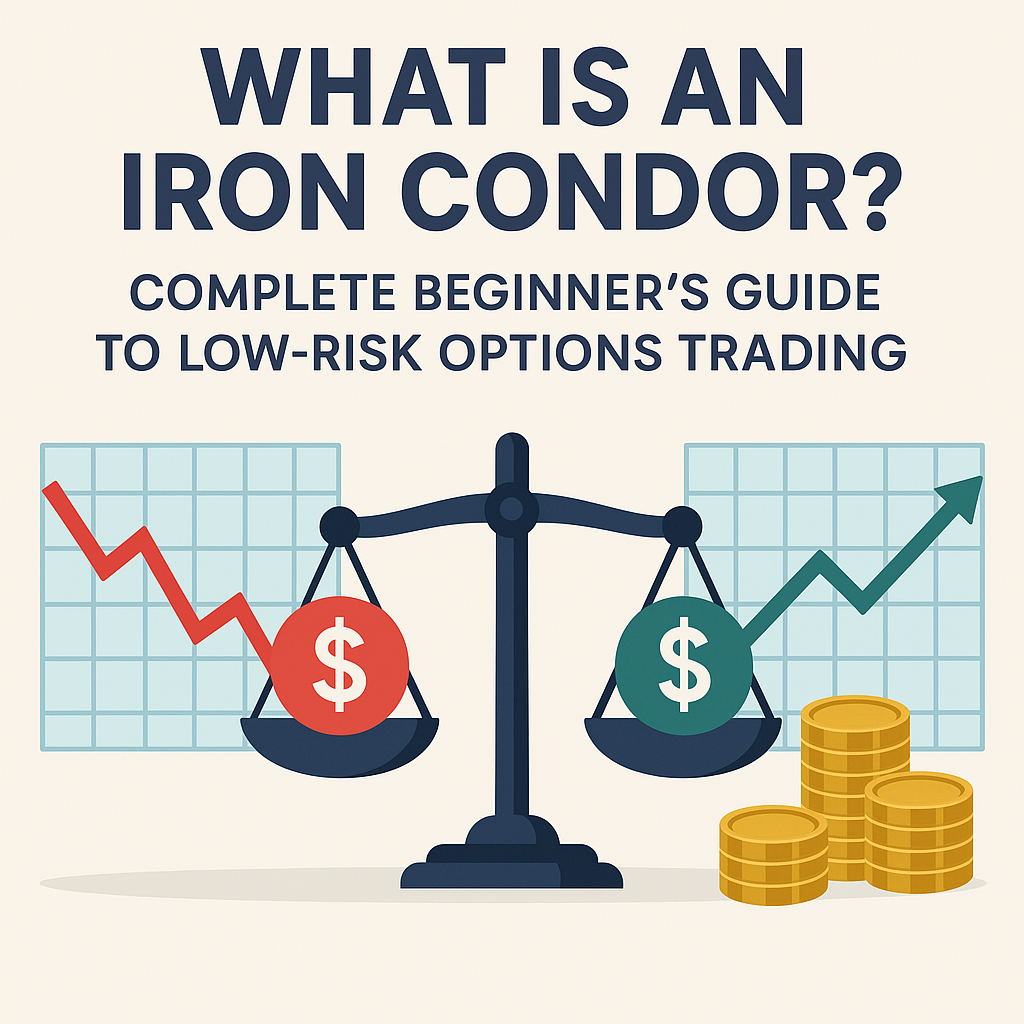What Is an Iron Condor?
The Iron Condor is a popular low-risk options trading strategy designed for neutral market conditions. By combining two credit spreads — a bull put spread and a bear call spread — traders aim to generate steady income while limiting potential losses. This guide will walk you through exactly how the Iron Condor works, why it’s favored by many conservative investors, and what you need to know before considering it as part of your options education.
Note: This article is for educational purposes only and does not provide investment advice.
How Is an Iron Condor Options Strategy Constructed?
The Iron Condor options strategy is composed of four options contracts: two calls and two puts, all with the same expiration date but with different strike prices. The structure looks like this:
- Sell one out-of-the-money (OTM) put
- Buy one further OTM put
- Sell one OTM call
- Buy one further OTM call
In simpler terms, the Iron Condor is a combination of two credit spreads:
- A bear call spread (using the two call options above the current price)
- A bull put spread (using the two put options below the current price)
The target profit zone lies between the two short strikes — the call you sold and the put you sold. As long as the underlying asset stays within this range at expiration, the trader keeps the full net premium received when opening the position.
This setup makes the Iron Condor strategy ideal for low-volatility markets, where large price movements are not expected.
Reference:
🟠 Iron Condor Options Strategy Example for Beginners (Educational Use Only)
To better understand how the Iron Condor options strategy works in practice, let’s walk through a simplified example.
Assume stock XYZ is currently trading at $100. A trader believes the stock will remain between $95 and $105 over the next month. Based on this neutral market outlook, the trader constructs the following Iron Condor position:
- Sell 1 $95 Put → collect $2.00
- Buy 1 $90 Put → pay $1.00
- Sell 1 $105 Call → collect $2.00
- Buy 1 $110 Call → pay $1.00
🔹 Net Premium Collected:
$2.00 + $2.00 – $1.00 + $1.00 = $2.00 total credit
🔹 Maximum Profit:
If stock XYZ closes between $95 and $105 at expiration, all options expire worthless, and the trader keeps the $2.00 premium as maximum profit.
🔹 Maximum Loss:
If the stock moves beyond either side of the spreads ($90 or $110), the maximum loss is the spread width ($5) minus the premium collected ($2):
$5.00 – $2.00 = $3.00 max potential loss
This example shows how the Iron Condor strategy offers limited risk and limited reward, making it a useful tool for traders with a neutral outlook who want to generate income from time decay.
Reference:
🔵 Pros and Cons of the Iron Condor Options Strategy
The Iron Condor options strategy is widely used by traders who want to benefit from time decay and stable market conditions. Like any trading strategy, it comes with both advantages and disadvantages. Understanding these can help new and experienced traders evaluate whether this neutral strategy aligns with their risk tolerance and market view.
✅ Pros of the Iron Condor Strategy
1. Defined Risk and Reward
Every Iron Condor trade has a clearly defined maximum profit and maximum loss. This makes risk management easier, especially for beginners learning how options spreads work.
2. Ideal for Neutral Markets
The strategy performs best when the underlying stock or index trades sideways. In a non-trending environment, the Iron Condor can generate consistent income from premium decay.
3. Time Decay Works in Your Favor
As the options approach expiration, their value decreases. Iron Condor sellers benefit from this theta decay, especially if the price stays within the targeted range.
4. Can Be Adjusted or Closed Early
Because it’s a multi-leg strategy, traders can adjust one side or close positions early if the market moves. This flexibility is useful for managing trades actively.
⚠️ Cons of the Iron Condor Strategy
1. Limited Profit Potential
The maximum gain is capped at the net premium received, which may be small compared to the capital at risk. Iron Condors are not designed for large returns from single trades.
2. Sensitive to Volatility Changes
If implied volatility increases after placing the trade, option prices can rise, leading to temporary or unrealized losses — even if the price remains within the range.
3. Requires Margin and Option Approval
Because it’s a multi-leg short option strategy, brokers typically require margin and special trading approval. Beginners may need to pass a suitability review before using it live.
4. Not Suitable for Trending Markets
If the market makes a strong directional move, the Iron Condor may suffer a full loss. It performs poorly during major news events, earnings surprises, or volatil
🟤 Iron Condor vs Other Neutral Strategies
I’ve kept your structure but expanded it into a proper educational comparison section — with clear explanations, SEO-friendly phrasing, and added value for your readers.
🟤 Iron Condor vs Other Neutral Options Strategies
When it comes to trading in a neutral or sideways market, several options strategies are available — each with its own structure, cost, risk profile, and ideal market conditions. Understanding the differences between them is essential for traders who want to choose the right tool for their market outlook.
Here’s a side-by-side comparison of three common neutral options strategies:
| Strategy Name | Basic Structure | Best Used In | Risk Profile |
|---|---|---|---|
| Iron Condor | Sell 1 OTM Put + Buy 1 lower Put Sell 1 OTM Call + Buy 1 higher Call | Sideways or low-volatility market | Fixed risk, fixed reward |
| Strangle | Buy 1 far OTM Call + Buy 1 far OTM Put | Anticipating large price movement in either direction | High risk, high cost |
| Butterfly Spread | 1 Buy Option (lower strike) + 2 Sell Options (middle strike) + 1 Buy Option (higher strike) | Very narrow range-bound market | Low risk, limited profit zone |
✅ Why Do Traders Choose the Iron Condor?
The Iron Condor options strategy is often favored for its simplicity, defined risk, and moderate profit potential. Compared to the other two:
- It requires less capital than a Strangle, which involves buying two options and often costs more in premium.
- It is easier to manage than a Butterfly Spread, which has a tighter profit zone and requires precise price movement.
- It’s more forgiving than both, as long as the stock stays within a reasonable range between the two short strikes.
🧠 Strategic Overview:
| Strategy | Key Goal | Trade-Off |
|---|---|---|
| Iron Condor | Generate income when price stays within a broad range | Limited profit, capped loss |
| Strangle | Profit from explosive moves (up or down) | Expensive, high risk of loss if market doesn’t move |
| Butterfly Spread | Target very specific price movement | Requires precise timing, narrower profit zone |
✅ Summary
For beginner to intermediate traders seeking a neutral, low-risk options strategy, the Iron Condor is often a practical choice. It strikes a balance between complexity and reward, with predictable outcomes and manageable loss scenarios.
While Strangles and Butterfly Spreads have their place in advanced strategies, they generally require more precision and are suited for traders with specific market forecasts or higher risk tolerance.
🔘 7. Summary & Final Thoughts
The Iron Condor options strategy is a powerful tool for traders who expect the market to remain range-bound. With its well-defined risk and reward structure, the strategy is especially suited for neutral market conditions where volatility is low. Throughout this article, we’ve explored how Iron Condors are constructed, how they work, and when they may be applied.
While this strategy can be valuable in the right market environment, it’s important to remember that real-world trading involves many variables — including slippage, execution timing, and unexpected market events.
This article is for educational purposes only and should not be used as a substitute for licensed financial advice or hands-on experience. Always backtest thoroughly and consider starting with paper trading before going live.
🟤 8. Historical Use of the Iron Condor in Sideways Markets
Over the past decade, global markets have experienced several extended periods of consolidation and low volatility — ideal conditions for implementing Iron Condor strategies. Below are a few notable examples:
- 2015 S&P 500 Sideways Phase
The S&P 500 moved between 2,000 and 2,130 points for nearly six months, forming a textbook range-bound environment. Traders using Iron Condors during this time were able to benefit from time decay. - Q2 2021 – Tech Slowdown
After strong gains, tech stocks paused, and volatility contracted. Traders began using Iron Condors to profit from the stagnation while collecting premium in quiet markets. - Early 2023 – Pre-ChatGPT AI Stock Consolidation
Despite buzz around AI stocks, many large-cap names like NVIDIA and AMD entered brief consolidation zones. The Iron Condor became a preferred structure for neutral-to-non-directional traders awaiting a breakout.
📌 These examples are not trading recommendations but serve to illustrate how the Iron Condor strategy may align with specific market conditions.
🔘 9. Iron Condor FAQs (Frequently Asked Questions)
Q1: Is the Iron Condor strategy only for advanced traders?
A: Not necessarily. While it involves four options contracts, the structure is quite logical once you understand basic spreads. It’s often the next step after learning bull put or bear call spreads. However, it’s highly recommended to practice with a paper trading account first.
Q2: What is the typical time frame for Iron Condor trades?
A: Most traders use Iron Condors on options with 15 to 45 days to expiration. Shorter periods may not offer enough premium, while longer durations introduce more uncertainty. A 30-day window is commonly used in educational materials.
Q3: Can Iron Condors be used on indices or ETFs, or only on individual stocks?
A: Absolutely. Iron Condors are often used on major indices like SPX, NDX, or ETFs like QQQ, IWM, and even high-volume blue-chip stocks such as AAPL or MSFT. These assets often have tighter bid-ask spreads and more stable movement.
Q4: Why do some traders say the Iron Condor is “low profit but steady”?
A: Because the Iron Condor’s maximum profit is capped — you can only earn the net premium — but the probability of profit (POP) can be high, especially when using wider ranges. It’s favored by traders looking to generate consistent income, not huge gains.
🔘 Additional Insights: Managing Risk with Iron Condors
An important aspect of trading the Iron Condor options strategy is active risk management. While the position has defined maximum loss, traders often adjust or exit the trade early to reduce exposure. For instance, if one side of the spread (either the calls or puts) is being threatened as the underlying approaches a short strike, a trader may choose to close the entire position or roll the untested side to a new strike. Another approach involves monitoring delta exposure — if the short options become too directional, adjustments can help neutralize the risk. Additionally, many traders aim to take profits early (e.g., at 50–70% of maximum gain) rather than holding until expiration. This reduces time-in-trade and exposure to surprise volatility. By combining proper trade selection with active monitoring, the Iron Condor can become a highly effective strategy for building consistent, low-risk income over time.
⚙️ 10. Managing Risk in Iron Condor Trades
A crucial element in mastering the Iron Condor options strategy is understanding how to manage risk effectively. Although the strategy is defined-risk by design, active monitoring and timely adjustments can significantly improve outcomes.
For example, if the price of the underlying asset moves close to one of the short strikes — either the call or the put — a trader may choose to close the entire position early or roll one side of the spread to new strikes, extending duration or widening the range.
Another technique involves tracking delta exposure: if the net position becomes too directional, traders can rebalance by shifting strikes or adding offsetting contracts.
In addition, many traders prefer to take profits early (e.g., once 50–70% of the maximum profit is reached), which limits exposure to sudden volatility spikes or earnings surprises. These proactive risk controls help turn the Iron Condor into a disciplined, repeatable income strategy — especially for neutral markets.
🧾 ⚠️ Disclaimer (Important)
This article is intended for educational purposes only and does not constitute financial advice or a recommendation to trade any security or strategy. Options trading involves significant risk and is not suitable for all investors.
Please consult a licensed financial advisor before making any investment decisions.








